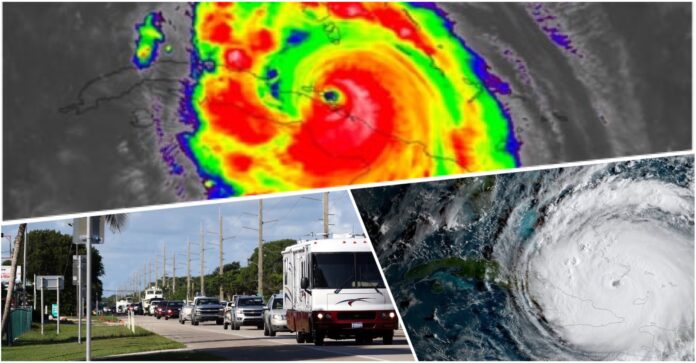Hurricane IRMA currently Category type 3 hurricane is heading straight towards the state of Florida. It is expected for IRMA to regain its strength as category 4 hurricane when it reaches the coast of Florida. FEMA – Federal Emergency Management Agency (Florida’s Division) has instructed an evacuation, a mix of mandatory and voluntary evacuation orders to almost 7 million residents.
‘‘If you are planning to leave and do not leave tonight, you will have to ride out this extremely dangerous storm at your own risk,’’ Florida Gov. Rick Scott stated – He urged everybody in the Keys to get out and evacuate.
“You need to leave — not tonight, not in an hour, right now,” Scott said at news conference. “This is the most catastrophic storm the state has ever seen.”
“We can rebuild your home, but we cannot rebuild your life,”
A storm surge is the water that is pushed onto shore by a hurricane. For coastal cities like Miami and Miami Beach, they can be catastrophic .
In the Florida Keys, the surge could reach as high as 10 feet, according to the National Hurricane Center. When Hurricane Andrew made landfall in 1992, the surge rose to about 6 feet.
“Remember Hurricane Andrew was one of the worst storms in the history of Florida,” Scott said. “Irma is more devastating on its current path.… This is a catastrophic storm that our state has never seen.”
Curfews are being issued across South Florida as state is preparing to be hit by Hurricane Irma.
Lines of traffic were seen on interstate highways, on Friday, as Floridians began to exit the state en masse, in anticipation of Hurricane Irma. Drone footage captured the scale of the exodus.
Traffic queues up as Floridians flee path of incoming Hurricane Irma.


Source: Ruptly
Hurricane Irma has been called the most powerful Atlantic hurricane ever recorded, having already hit several Caribbean island nations, including Puerto Rico, Dominican Republic and Haiti, en route to the United States mainland.
Safety Tips by FEMA:
Preparedness Tips
- Know where to go. If you are ordered to evacuate, know the local hurricane evacuation route(s) to take and have a plan for where you can stay. Contact your local emergency management agency for more information.
- Put together a go-bag: disaster supply kit, including a flashlight, batteries, cash, first aid supplies, medications, and copies of your critical information if you need to evacuate
- If you are not in an area that is advised to evacuate and you decide to stay in your home, plan for adequate supplies in case you lose power and water for several days and you are not able to leave due to flooding or blocked roads.
- Make a family emergency communication plan.
- Many communities have text or email alerting systems for emergency notifications. To find out what alerts are available in your area, search the Internet with your town, city, or county name and the word “alerts.”
Preparing Your Home
- Hurricane winds can cause trees and branches to fall, so before hurricane season trim or remove damaged trees and limbs to keep you and your property safe.
- Secure loose rain gutters and downspouts and clear any clogged areas or debris to prevent water damage to your property.
- Reduce property damage by retrofitting to secure and reinforce the roof, windows and doors, including the garage doors.
- Purchase a portable generator or install a generator for use during power outages. Remember to keep generators and other alternate power/heat sources outside, at least 20 feet away from windows and doors and protected from moisture; and NEVER try to power the house wiring by plugging a generator into a wall outlet.
- Consider building a FEMA safe room or ICC 500 storm shelter designed for protection from high-winds and in locations above flooding levels.
Hurricane Watch
Hurricane watch = conditions possible within the next 48 hrs.
Steps to take:
- Review your evacuation route(s) & listen to local officials.
- Review the items in your disaster supply kit; and add items to meet the household needs for children, parents, individuals with disabilities or other access and functional needs or pets.
Hurricane Warning
Hurricane warning = conditions are expected within 36 hrs.
Steps to take:
- Follow evacuation orders from local officials, if given.
- Check-in with family and friends by texting or using social media.
- Follow the hurricane timeline preparedness checklist, depending on when the storm is anticipated to hit and the impact that is projected for your location.
What to do when a hurricane is 6 hours from arriving
- If you’re not in an area that is recommended for evacuation, plan to stay at home or where you are and let friends and family know where you are.
- Close storm shutters, and stay away from windows. Flying glass from broken windows could injure you.
- Turn your refrigerator or freezer to the coldest setting and open only when necessary. If you lose power, food will last longer. Keep a thermometer in the refrigerator to be able to check the food temperature when the power is restored.
- Turn on your TV/radio, or check your city/county website every 30 minutes in order to get the latest weather updates and emergency instructions.
What to do when a hurricane is 6-18 hours from arriving
- Turn on your TV/radio, or check your city/county website every 30 minutes in order to get the latest weather updates and emergency instructions.
- Charge your cell phone now so you will have a full battery in case you lose power.
What to do when a hurricane is 18-36 hours from arriving
- Bookmark your city or county website for quick access to storm updates and emergency instructions.
- Bring loose, lightweight objects inside that could become projectiles in high winds (e.g., patio furniture, garbage cans); anchor objects that would be unsafe to bring inside (e.g., propane tanks); and trim or remove trees close enough to fall on the building.
- Cover all of your home’s windows. Permanent storm shutters offer the best protection for windows. A second option is to board up windows with 5/8” exterior grade or marine plywood, cut to fit and ready to install.
What to do when a hurricane is 36 hours from arriving
- Turn on your TV or radio in order to get the latest weather updates and emergency instructions.
- Build or restock your emergency preparedness kit. Include food and water sufficient for at least three days, medications, a flashlight, batteries, cash, and first aid supplies.
- Plan how to communicate with family members if you lose power. For example, you can call, text, email or use social media. Remember that during disasters, sending text messages is usually reliable and faster than making phone calls because phone lines are often overloaded.
- Review your evacuation plan with your family. You may have to leave quickly so plan ahead.
- Keep your car in good working condition, and keep the gas tank full; stock your vehicle with emergency supplies and a change of clothes.
After a Hurricane
- Listen to local officials for updates and instructions.
- Check-in with family and friends by texting or using social media.
- Return home only when authorities indicate it is safe.
- Watch out for debris and downed power lines.
- Avoid walking or driving through flood waters. Just 6 inches of moving water can knock you down, and one foot of fast-moving water can sweep your vehicle away.
- Avoid flood water as it may be electrically charged from underground or downed power lines and may hide dangerous debris or places where the ground is washed away.
- Photograph the damage to your property in order to assist in filing an insurance claim.
- Do what you can to prevent further damage to your property, (e.g., putting a tarp on a damaged roof), as insurance may not cover additional damage that occurs after the storm.
Source: FEMA, FOX, LaTimes, BostonGlobe
TBU NEWS



